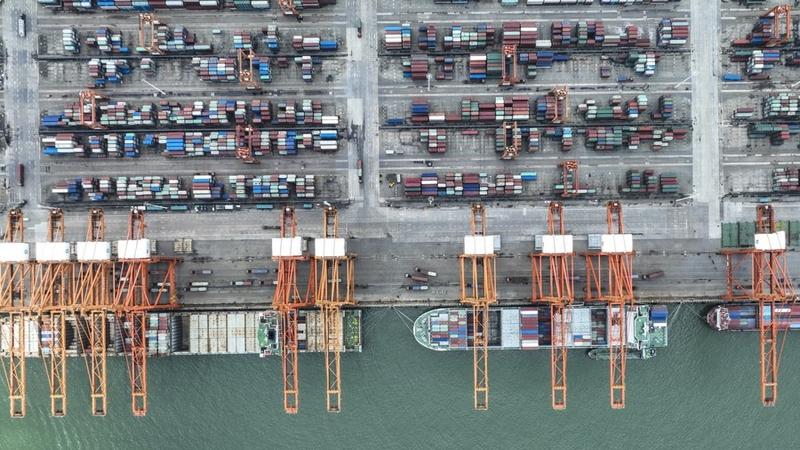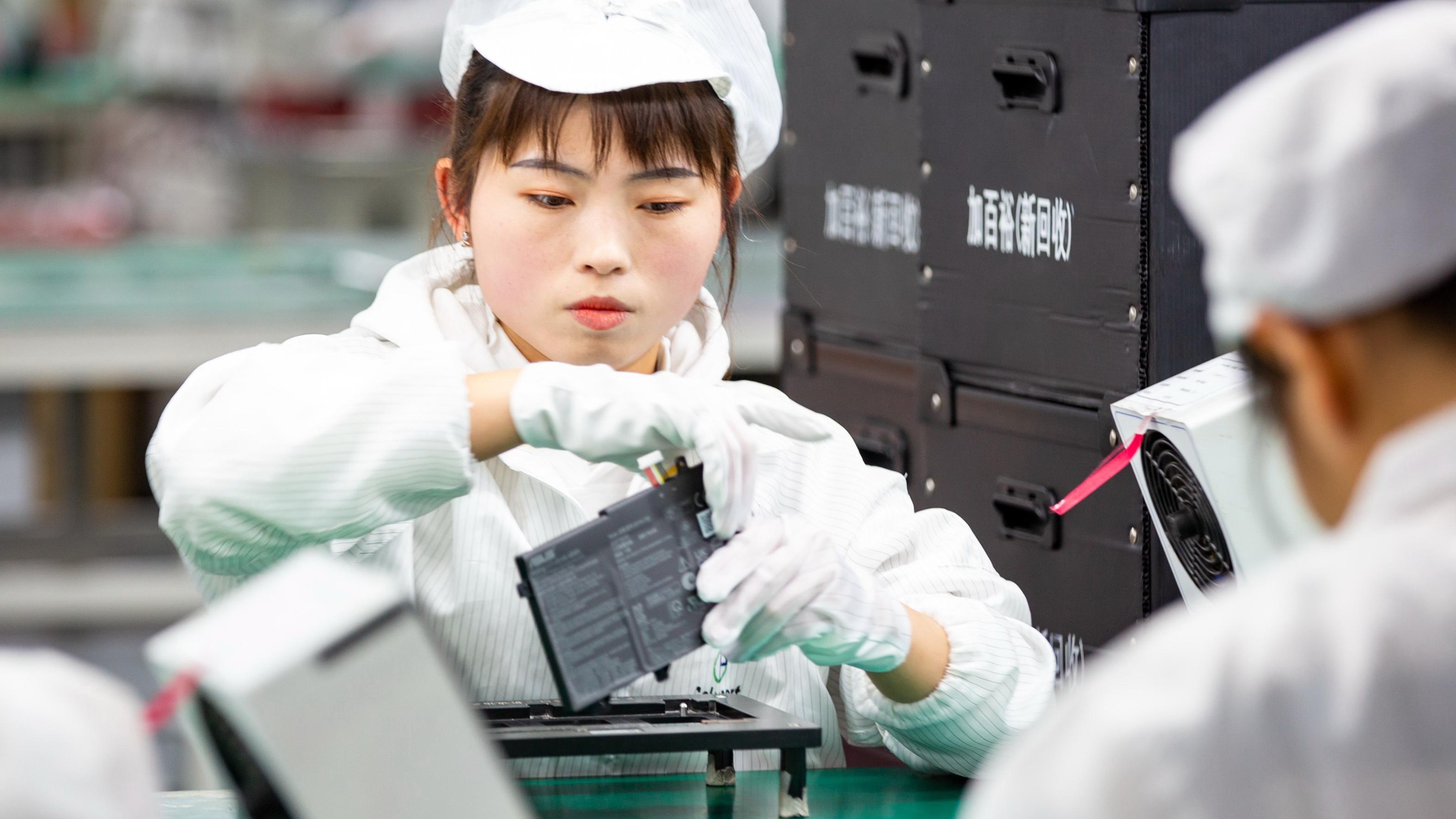 This aerial photo taken on July 22, 2023 shows a container wharf of the Beibu Gulf Port in Qinzhou, south China's Guangxi Zhuang autonomous region. (PHOTO / XINHUA)
This aerial photo taken on July 22, 2023 shows a container wharf of the Beibu Gulf Port in Qinzhou, south China's Guangxi Zhuang autonomous region. (PHOTO / XINHUA)
A combination of three factors is changing the face of China's foreign trade.
The three factors are soaring demand for certain Chinese products abroad; challenges like export controls imposed by certain countries that have spawned new opportunities for Chinese companies; and the emergence of three new categories of products as drivers of exports.
This, in turn, is encouraging more Chinese companies to go global as well as attracting foreign firms to China. And those with existing operations are eyeing expansion, both within and outside China.
Chinese carmaker BYD's factory in Xi'an, capital of Northwest China's Shaanxi province, is a good example of the trend. The facility produces 900,000 fuel-powered and electric vehicles a year, averaging about 2,460 a day. On a typical work day at its workshop, about 120 workers busily assemble sedans that will eventually scorch roads and highways in Central Asia, Europe, South America and Southeast Asia.
Tech-intensive green products, supportive policy measures and private-sector companies' expansion in emerging markets will drive China's exports in the years ahead, said Zhou Maohua, a macroeconomic researcher at China Everbright Bank
Fueled by soaring overseas demand, especially for EVs, BYD's exports will jump from 55,916 units in 2022 to 250,000 units this year. The Shenzhen, Guangdong province-headquartered group will decide on the location of its first factory in Europe by the end of this year, said Li Yunfei, general manager of BYD's branding and public relations department.
About 1,260 kilometers away from BYD's Xi'an plant, Rugao Customs, a branch of Nanjing Customs, recently completed sampling lithium battery products used for energy storage, for export to Mozambique.
These power storage products, manufactured by Chengrui Power Technology (Shanghai) Co's Nantong plant in East China's Jiangsu province, will give businesses and people in Africa more options to use electricity, said Zhang Xiaochun, deputy head of Rugao Customs.
As electricity is becoming pricier in some African countries where power grid systems are unstable as well, photovoltaics combined with energy storage can enhance the level of self-generated electricity consumption, mitigate the impact of rising electricity costs and provide a more stable power supply, said Hu Jinhang, head of Chengrui Power's Rugao branch.
ALSO READ: China supports foreign trade firms to branch out overseas
The examples above highlight how, amid declining demand for global goods and disruptions to global supply chains, certain Chinese companies are extending their global footprint.
 This file photo taken on Feb 15, 2023 shows a workshop of Chinese electric vehicle (EV) maker Li Auto Inc in Changzhou, Jiangsu province. (PHOTO / XINHUA)
This file photo taken on Feb 15, 2023 shows a workshop of Chinese electric vehicle (EV) maker Li Auto Inc in Changzhou, Jiangsu province. (PHOTO / XINHUA)
China's foreign trade landscape is evolving toward sustainability, with traditional export categories such as clothing and furniture making way for high-tech innovations in the new energy and high-end manufacturing sectors.
Tech-intensive green products, supportive policy measures and private-sector companies' expansion in emerging markets will drive China's exports in the years ahead, said Zhou Maohua, a macroeconomic researcher at China Everbright Bank.
Robust export performance of the "new three" — electric vehicles, lithium batteries and solar cells — is believed to have led to export growth, said Zhang Jianhong, executive director of the environmental technology and economics branch at the Beijing-based Chinese Society of Technology Economics
China's foreign trade rose marginally year-on-year in the first 10 months of this year to 34.32 trillion yuan ($4.76 trillion). It rose by 0.9 percent year-on-year in October, the first positive growth in the second half, data from the General Administration of Customs showed.
Robust export performance of the "new three" — electric vehicles, lithium batteries and solar cells — is believed to have led to export growth, said Zhang Jianhong, executive director of the environmental technology and economics branch at the Beijing-based Chinese Society of Technology Economics.
The export value of China's "new three" products has maintained double-digit growth for 14 consecutive quarters, with a year-on-year increase of 41.7 percent to 798.99 billion yuan in the first three quarters of this year, accounting for 4.5 percent of the country's total exports, according to government data.
Zhang Yansheng, chief researcher at the Beijing-based China Center for International Economic Exchanges, said these products have become a crucial growth engine for exports, illustrating the continuous optimization of China's foreign trade structure, the gradual strengthening of new trade momentum and the effective implementation of stable foreign trade policies.
For instance, Chengrui Power has received multiple energy storage battery orders from countries participating in the Belt and Road Initiative in Africa and other emerging markets. It has cumulatively exported nearly 400 lithium battery packs to countries such as Nigeria, Ghana, Benin and Indonesia since July. Its production plan is scheduled until June 2024.
Chen Bin, deputy director of the expert committee at the Beijing-based China Machinery Industry Federation, said the emergence of tech-intensive green products is not coincidental. Through years of accumulating technology, building a solid industrial foundation and cultivating markets, China has developed robust competitiveness in both industry and products.
ALSO READ: Double 11 shopping festival injects vigor into foreign trade
 In this undated file photo, employees work on the production line of a lithium battery producer in Hai'an, Jiangsu province. (ZHAI HUIYONG / FOR CHINA DAILY)
In this undated file photo, employees work on the production line of a lithium battery producer in Hai'an, Jiangsu province. (ZHAI HUIYONG / FOR CHINA DAILY)
"Take new energy vehicles as an example. China has become a major producer and seller of new energy vehicles in just over two decades, achieving rapid growth in this sector," said Chen, adding the market explosion and the release of production capacity at this moment reflect the effective improvement of China's export quality and the rational growth in quantity, highlighting the forward-looking nature of China's economic development.
Sharing similar views, Wei Jianguo, vice-chairman of the CCIEE, said that amid certain Western countries' heightened containment efforts (like export controls on high-end technologies, additional tariffs and manufacturing reshoring) to target China's industrial chains, the Chinese industrial community is increasingly vigilant about the challenges in this context.
Highlighting China's massive market, sophisticated industrial system and strong supply chain competitiveness, Arnold Li, senior vice-president of Ingersoll Rand, a US-based industrial goods manufacturer, said the company plans to enhance its investment in innovation capabilities, focusing particularly on digitalization and technologies for the new energy-related sectors in China over the long run
In response, China's industrial upgrades are gaining momentum, enhancing the country's competitiveness across various sectors, including new energy-related and high-tech industrial chains, said Wei.
Boosted by these factors, China saw steady export growth of such mechanical and electrical products as data processing devices, cell phones and automobiles from January to October, growing by 2.8 percent on a yearly basis to 11.43 trillion yuan, accounting for 58.5 percent of the country's total exports. In particular, exports of automobiles totaled 582.4 billion yuan, up 88.5 percent year-on-year, Customs data showed.
As the International Monetary Fund raised its 2023 growth projection for the Chinese economy from 5 percent to 5.4 percent in early November, multinational corporations, which accounted for 30.5 percent of China's total foreign trade value from January to October, said they are also seeing more export opportunities in areas such as green economy, advanced manufacturing and innovation-driven growth in the world's second-largest economy.
To realize these prospects, they have increased their investments, broadened their business portfolios and formulated medium- to long-term plans for consistent growth. They are expected to continue to do so, as optimistic as they are about China's anticipated high-quality economic upgrade in the coming years.
 Hundreds of solar panels of a photovoltaic plant float on a reservoir in Liaocheng, Shandong province. (PHOTO / ZHANG ZHENGXIANG FOR CHINA DAILY)
Hundreds of solar panels of a photovoltaic plant float on a reservoir in Liaocheng, Shandong province. (PHOTO / ZHANG ZHENGXIANG FOR CHINA DAILY)
Highlighting China's massive market, sophisticated industrial system and strong supply chain competitiveness, Arnold Li, senior vice-president of Ingersoll Rand, a US-based industrial goods manufacturer, said the company plans to enhance its investment in innovation capabilities, focusing particularly on digitalization and technologies for the new energy-related sectors in China over the long run.
China, he said, has progressively bolstered its innovation and production capabilities. This will enable Ingersoll Rand to export more of its products made in China, particularly to signatory countries of the Regional Comprehensive Economic Partnership and economies participating in the BRI.
READ MORE: Foreign trade performance will continue to improve, experts say
As demand in China is surging, Elkem has recently started producing high-end electronic adhesives for silicone at its Shanghai plant. This facility is dedicated to manufacturing high-end products within its thermal conductivity series
Elkem, a Norway-based integrated silicone manufacturer, will invest in new capacities and products in China, with a batch of new capacities and products set to come into operation at its plants in places such as Shanghai and Jiangxi province in the first half of 2024.
As demand in China is surging, Elkem has recently started producing high-end electronic adhesives for silicone at its Shanghai plant. This facility is dedicated to manufacturing high-end products within its thermal conductivity series.
Zhang Lijun, senior vice-president of the Oslo Stock Exchange-listed company, said these new investments aim to provide advanced silicone products for clients in China and other countries in the Asia-Pacific region.
In addition to opening up more avenues for global companies' expansion in China and supporting the country's exports of tech-intensive green products, the GAC in late October introduced 16 reform measures to promote high-quality development in processing trade, to further enhance the role of policy guidance in supporting the gradual evolution of industries within China.
Processing trade refers to the business activity of importing all, or some of, the raw and auxiliary materials from abroad, and re-exporting the finished products after processing or assembly by companies within the Chinese mainland.
The new policies encourage the import of energy and resource commodities such as crude oil, coal, natural gas, iron ore, copper concentrate and grains, said Huang Lingli, deputy director-general of the GAC's commodity inspection department.
She said this involves the construction of bonded warehouses and transportation bases in the main import areas of China's central, western and northeastern regions, facilitating on-site processing trade to stabilize the supply and industrial chains of strategic commodities.


